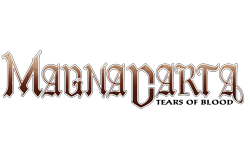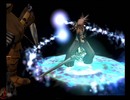|
|

|
BATTLE SYSTEM
|

|
INTERACTION
|

|
ORIGINALITY
|

|
STORY
|

|
MUSIC & SOUND
|

|
VISUALS
|

|
CHALLENGE
|
Easy
|
COMPLETION TIME
|
40-60 Hours
|
|
OVERALL
2.0/5
|
Rating definitions
|
|
|
The mercenary unit Tears of Blood, led by a swordsman named Calintz, has seen its fair share of missions in the war against the Yason, a civilization of humanoid creatures. Interspecies tension and hatred have grown to the point of prejudice over the years. Only Reith, a girl who seems to be a priestess who has lost her memory and regressed to a childlike state, does not bare hatred towards them. Her encounter with Calintz results in a chain of events that will determine the fate of the world of Magna Carta: Tears of Blood. As one would expect from a mercenary group in a time of war, the Tears of Blood will find themselves in hundreds of battles as the game progresses. Unfortunately, the battle system is rather complicated and is affected by many components that exist before the fighting even begins.
A force known as chi flows throughout the world and is composed of elements such as Lightning and Water. Each region has its own balance of chi elements which is affected by glowing orbs known as lanterns. By placing a magical item, known as a talisman, with a different element in a lantern, players can alter the balance of chi so that it is more favorable. This is important because each skill the heroes use draws chi from the environment. Not only are techniques of a certain element unusable once its respective chi is used up, they also become weaker as the chi begins to run out. As time passes, the environmental chi will slowly return to normal, but this gives the enemy a chance to get the upper hand if the player has expended their elements. Another out-of-battle factor that plays a huge part in fights is which side strikes first. With weapons drawn, the heroes can walk through fields and dungeons, slowly sneaking up on enemies. Should they be successful, they will gain an enormous amount of time to mop the floor with the enemies before they have a chance to retaliate, but no side has an advantage if the enemy spots the sneak attack before it is executed. On the other hand, should the player haphazardly run through the terrain, enemies will be able to perform sneak attacks on them instead of the other way around.
 Awesome special effects? Yeah, it has those.
Awesome special effects? Yeah, it has those.
|
|
Once the fight actually begins, actions are determined by the Leadership Gauge which slowly fills up in real time, though it stops when a character is moving. Both heroes and enemies have one, and it has several markings along it that are determined by factors such as Charisma, how many fighters are on each side, and their trust in their leader. When one of these markings is passed, one character can change fighting styles if they desire and use a magic item or skill. Unfortunately, the only real control over which skills are used is based on which styles are equipped at the time. Though each style has multiple techniques associated with it, they are all executed in ascending order until the most powerful one is reached. When a skill is used, a circle appears on the screen with three Os and/or Xs along the circumference. The circle will quickly spin and the player must press the corresponding button as the Os and Xs reach the top. If the player is dead on, they will receive a Great and deal extra damage. Three greats will also increase a special gauge, known as the trinity gauge, that can be used to perform incredibly powerful attacks. Missing, on the other hand, will cause the leadership gauge to decrease, the current style to revert to its weakest attack, and the trinity gauge to return to zero. This is probably sounding pretty complicated right about now, but it's just the tip of the iceberg. There are also shield icons, fortune tellings, and counter and combo settings, to name a few.
Unfortunately, the battle system isn't much fun even after the steep learning curve has been passed. Normal battles go something like this for much of the game, provided the heroes get the first strike: one hero runs up to the enemy pack and basically beats the living daylights out of them while the other heroes stand in the sidelines and cheer him or her on. There is little variety in this, it is simply mindlessly pushing the buttons that appear on the screen for several minutes until the enemies are almost all defeated or the chi is depleted. At this point, the enemy might possibly get some hits in, but their fate was sealed from the beginning. Besides being almost completely one-sided, battles almost always take several minutes to complete. They become more of a nuisance than anything else. Boss fights involve more strategy and generally involve more than one hero, but the battle system isn't that good to begin with.
Magna Carta: Tears of Blood is, in general, an easy game. It's quite easy to go through the game's early dungeons and only take a hit or two, not counting bosses. It is also possible to combine talismans to create more powerful ones. By doing so, it becomes possible to create spells of enormous power with minimal cost. Even most bosses barely pose a threat so long as the player is willing to spend a little extra money replenishing these items. As unfortunate as it might be, the largest cause of challenge to the player is the interface.
To put it simply, the camera is awful. It moves erratically, often switches angles at inopportune moments, and commonly makes it very difficult to see enemies without the aid of the radar, which was thankfully included. Though it doesn't appear in battle, the radar makes life a lot easier for the player. Another problem with the interface is a strange bug that causes the selected player to run off in a strange direction if the analog stick is held at the beginning of battle. Thankfully, the game's menus and localization are generally much higher in quality, though it would have been useful if trust levels were displayed in the formation screen.
 Combine spells to create even stronger magic.
Combine spells to create even stronger magic.
|
|
Though the end result isn't particularly good, the game does get some credit for trying something new. Though most of the components of the battle system are tweaked versions of those that exist in other games tossed together, there is still a good deal of innovation to be found. The turn and style systems in particular are fairly original.
Long dungeons and drawn out battles combine to create a considerable amount of playtime, though it probably helps that the heroes are forced to walk slowly with their weapons drawn to avoid being ambushed. This is definitely one of the longer RPGs around clocking in around fifty or sixty hours, though, if enemies are avoided as much as possible, it might be feasible to complete it in forty.
Magna Carta: Tears of Blood has a good deal of flaws, but it is not without merits. Those willing to crawl through dungeons and countless enemies at a snail's pace will be rewarded with a rather good story. Though it is hurt slightly by poor pacing, the characters are well-developed and the story is enjoyable.
Another very positive aspect of the game is its visuals. Aside from some of the less important NPCs, character models have been given a considerable amount of detail. Skill effects are often very nice to watch, even those that have been used numerous times before. It is very rare for a game to be able to pull that off this well, but the weaker moves are quick and the stronger moves generally look incredible. Beautiful artwork and the rare FMV accompany this and make Magna Carta: Tears of Blood one of the best looking games on the PS2.
While nowhere as good as the visuals, the music is a small plus. Some of the background music may get on some people's nerves by the end of the game, but at least some extra effort went in to making sure that didn't happen very often. For example, there are numerous battle tracks divided among ordinary fights and boss battles. This added touch is much appreciated. Sound effects are generally pretty good, though the heroes have a very limited selection of voice clips.
Magna Carta: Tears of Blood is not without the merits of a good story and beautiful graphics, but it is riddled with flaws, both minor and major, that can sap the fun out of many aspects of the game. Combine this with a poor battle system and the fact that the game moves at a snail's pace and the result isn't particularly good. Those willing to spend fifty or so hours wandering through dungeons will find nice scenery and a good story along the way, but others are better off looking elsewhere.
Review Archives
|









